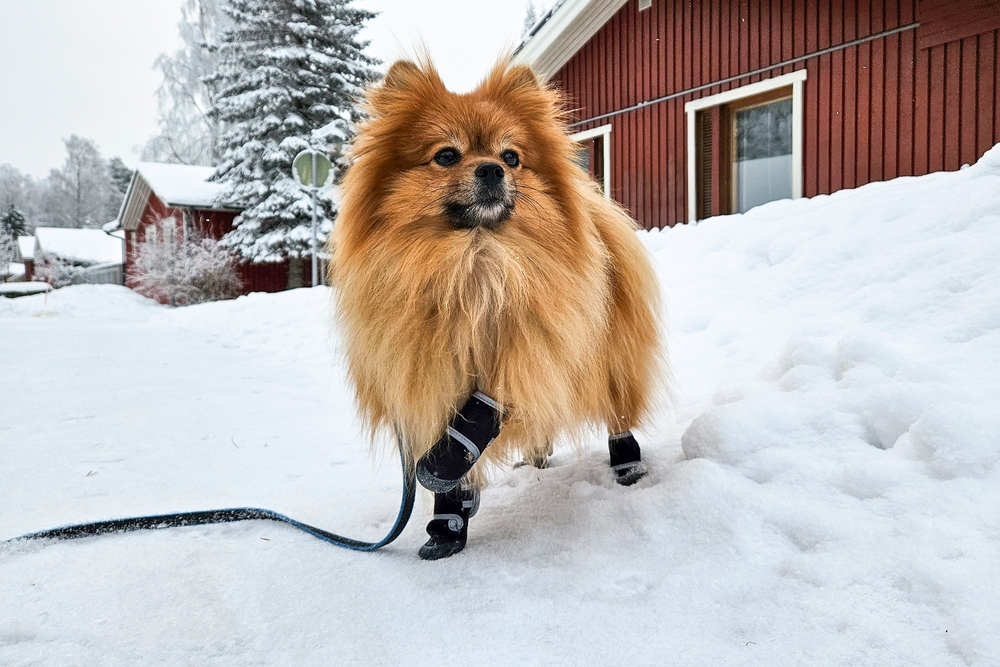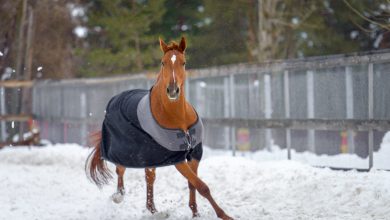How to Protect Dog Paws in Winter: 10 Vet-Reviewed Tips & Tricks

Winter can be a challenging time for our pets. The temperature is one thing, but it also poses new health risks that don’t exist when conditions are less demanding. Staying warm is crucial since it can affect an animal’s chances of staving off hypothermia. Other concerns rest with their extremities, including their paws, as they come in direct contact with the cold.
Some breeds, like Siberian Huskies, are more cold-tolerant than others. They have adapted to these extreme conditions in ways that make it less stressful and harmful for them. They seem to relish the freezing temperatures. However, protecting a dog’s paws must be at the forefront because these body parts are vulnerable to frostbite and its complications.


Before You Start
Several factors affect the safety of walking your dog outside. Snowstorms are an obvious issue, but bitter wind chills and extreme temperatures are another concern. The cold will impact small pets more than large animals because of their varying surface area ratios. So, you might consider alternative indoor options like pee pads for toy breeds.
However, there is a lot more that goes into protecting a dog’s paws during the winter. Let’s go over some of our best tips and tricks to ensure your pup’s paws stay protected.


The 10 Tips for Protecting Dog Paws During Winter
1. Check the Conditions Before Heading Outside
A walk during a snowstorm may sound romantic, but your dog may feel otherwise. It can make a simple small task into a big chore. Therefore, we suggest checking the weather before going outside for anything coming your way during your usual time outdoors. You may find a walk in the neighborhood a better choice than hitting the trail if inclement weather is approaching.


2. Keep Your Pet’s Paws in Good Shape
We recommend keeping your dog’s paws in good shape by trimming their nails and clipping the excess hair around their feet. That can prevent ice from forming on their fur and making painful ice balls between their pads. Of course, the more you handle your dog’s feet, the more they will become used to it. It’ll make it more manageable to examine them if you notice your pet limping or showing other signs of discomfort.
3. Invest in a Pair of Dog Boots
Dog boots may seem silly, but they are practical. They can prevent many cold-related injuries by providing an extra layer between your pet’s paws and the frozen ground. The design of these products has come a long way from the old-fashioned, galosh-styled boots. They are more comfortable and secure. Manufacturers have even made them look sporty and fashionable. Just be sure to try different kinds to find a product your dog will tolerate.


4. Get Your Pet Used to Wearing the Boots
Boots are a sound investment, but they do little good if your pet refuses to wear them. Getting your pet used to the feeling of the boots is essential for protecting their paws when it matters most. Treats are an excellent way to overcome any objections your dog may have to them. Reward your pooch and praise them for tolerating the boots, and be sure to keep up with these lessons year-round.
5. Check Your Pet’s Paws Before Going Outdoors
You can avoid many issues with your pet’s paws by checking them before going outside in winter conditions. Cracking and open sores can make them more vulnerable to further injuries and complications. We suggest massaging their pads to determine if there are any problems which could lead to further issues.


6. Buy Some Paw Balm
Sometimes, boots are overkill, and some dogs might refuse to tolerate them. However, that doesn’t mean you should neglect your dog’s paws. We recommend getting some paw balm to protect them during inclement weather. These products are pet-friendly and safe to use for animals that may lick the balm off their paws.
7. Shovel Walkways Around Your House
The chances are that you’re going to walk your dog someplace where it’s already been shoveled. That can reduce problems with their paws. However, take the same message to your home. Make sure to keep all areas where your dog may walk clear, such as the driveway or the pathways they use to run around the house.


8. Use a Pet-Friendly Deicing Product
Deicing products are sometimes necessary for your safety. However, salt can do a number on your lawn, and many aren’t safe for pets. Luckily, some pet-friendly deicers exist that don’t carry the same risks. These products are a bit more expensive but worth the investment.
9. Wipe Their Paws After Coming in From a Walk
Assuming your walk outside is on sidewalks or pavement where the city applies deicing products, always make sure that you’re wiping your dog’s paws when they come in, as ingestion of these products can be highly toxic, and leaving them on there will cause damage to the paws.


10. Limit Their Time Outside
During the winter, it’s wise to limit your pet’s time outside if it can adversely affect their paws. It makes sense to make the most of your time outside to get the job done quickly to avoid issues. Pay attention to your pet’s habits to learn when the best time is to go outside to minimize the time they need to spend outdoors in the cold.


Final Thoughts
A dog’s paws are vulnerable to injury during challenging times like winter. Ice can be sharp and can hurt them, and cold temperatures can cause frostbite. Understanding the risks and taking protective actions are imperative to keeping your pet healthy. Technology has given us many tools to protect our animal companions, but it’s up to us to implement them.
Featured Image Credit: Pencil case, Shutterstock



